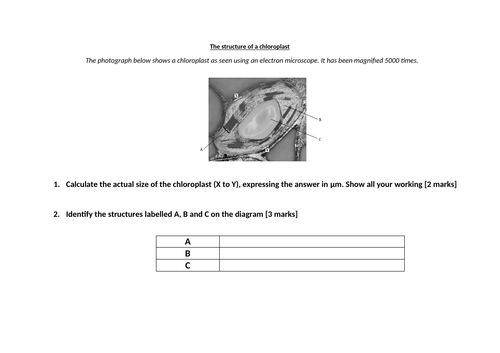




This lesson describes the relationship between the structure and function of the vacuole, chloroplast and cell wall, as found in plant cells. Additional structures, such as the nucleus and mitochondria, were covered in the previous lesson on the structure of eukaryotic animal cells and the detailed content of these two lessons has been designed in parallel to cover the main content of point 2.1.1 of the AQA A-level Biology specification.
The lesson begins with a task called REVERSE GUESS WHO which will challenge the students to recognise a cell structure from a description of its function. This will remind students that plant cells are eukaryotic and therefore contain a cell-surface membrane, a nucleus (+ nucleolus), a mitochondria, a Golgi apparatus, ribosomes and rough and smooth endoplasmic reticulum like the animal cells. Moving forwards, the rest of the lesson focuses on the relationship between the structure and function of the vacuole, chloroplast and cellulose cell wall. When considering the vacuole, key structures such as the tonoplast are described as well as critical functions including the maintenance of turgor pressure. A detailed knowledge of the structure of the chloroplast at this early stage of their A-level studies will increase the likelihood of a clear understanding of photosynthesis when covered in topic 5. For this reason, time is taken to consider the light-dependent and light-independent reactions and to explain how these stages are linked. The final part of the lesson challenges the students on their knowledge of cellulose as a polysaccharide as previously covered in topic 1. In addition to the focus on plant cells, the presence of chloroplasts and a cell wall in algae and the latter in fungi is also described.
The previous lesson which contains the content that ties in closely with this one has been uploaded under the title “Structure of eukaryotic (animal) cells”
Get this resource as part of a bundle and save up to 31%
A bundle is a package of resources grouped together to teach a particular topic, or a series of lessons, in one place.
Topic 2: Cells (AQA A-level Biology)
This bundle contains 19 PowerPoint lessons which are highly-detailed and are fully-resourced with differentiated worksheets. Intricate planning means that the wide range of activities included in these lessons will engage and motivate the students, check on their current understanding and their ability to make links to previously covered topics and most importantly will deepen their understanding of the following specification points in topic 2 (Cells) of the AQA A-level Biology specification: * Structure and function of the organelles in eukaryotic cells * The specialised cells in complex, multicellular organisms * The structure of prokaryotic cells * The structure of viruses which are acellular and non-living * The principles and limitations of optical, transmission electron and scanning electron microscopes * Measuring the size of an object under an optical microscope * Use of the magnification formula * The behaviour of chromosomes during the stages of the cell cycle * Binary fission * The basic structure of cell membranes * The role of phospholipids, proteins, glycoproteins, glycolipids and cholesterol * Simple diffusion * Facilitated diffusion * Osmosis, explained in terms of water potential * The role of carrier proteins and the hydrolysis of ATP in active transport * Co-transport as illustrated by the absorption of sodium ions and glucose by the cells lining the mammalian ileum * Recognition of different cells by the immune system * The identification of pathogens from antigens * The phagocytosis of pathogens * The cellular response involving T lymphocytes * The humoral response involving the production of antibodies by plasma cells * The structure of an antibody * The roles of plasma cells and memory cells in the primary and secondary immune response * The use of vaccines to protect populations * The differences between active and passive immunity * The structure of the human immunodeficiency virus and its replication in helper T cells * How HIV causes the symptoms of AIDS * Why antibiotics are ineffective against viruses * The use of antibodies in the ELISA test If you would like to sample the quality of these lessons, then download the eukaryotic animal cells, viruses, microscopes, osmosis, lymphocytes, HIV and AIDS lessons as these have been shared for free.
Topic 2.1: Cell structure (AQA A-level Biology)
This bundle of 8 lesson PowerPoints and accompanying resources contain a wide variety of tasks which will engage and motivate the students whilst covering the details of topic 2.1 of the AQA A-level Biology specification. Cells and their structure are linked to all of the other 7 topics in this course so a clear understanding is critical to a student's success. The tasks which include exam-style questions (with displayed mark schemes), discussion points and quiz competitions will cover the following parts of topic 2.1: * The structure and function of the cell-surface membrane, nucleus, nucleolus, mitochondria, chloroplasts, Golgi apparatus, lysosomes, ribosomes, RER and SER, cell wall and cell vacuole * The specialised cells of complex, multicellular organisms * The structures of a typical prokaryotic cell * The differences between prokaryotic and eukaryotic cells * The structure of viruses * The principles and limitations of optical microscopes, transmission electron microscopes and scanning electron microscopes * Measuring the size of an object using an optical microscope * Using the magnification formula If you would like to sample the quality of these lessons, then download the eukaryotic animal cells, viruses and microscopes lessons as these have been uploaded for free
Something went wrong, please try again later.
This resource hasn't been reviewed yet
To ensure quality for our reviews, only customers who have purchased this resource can review it
Report this resourceto let us know if it violates our terms and conditions.
Our customer service team will review your report and will be in touch.